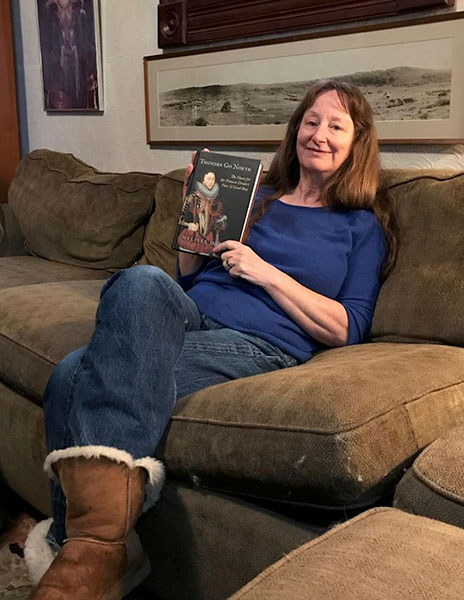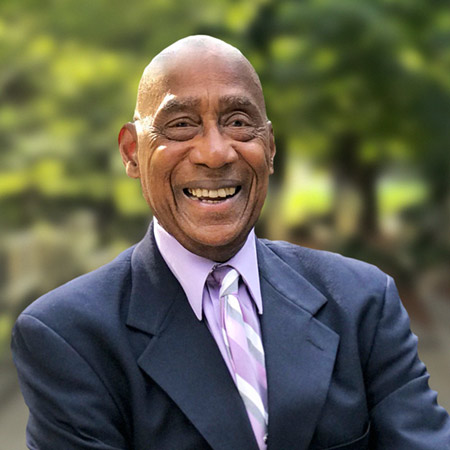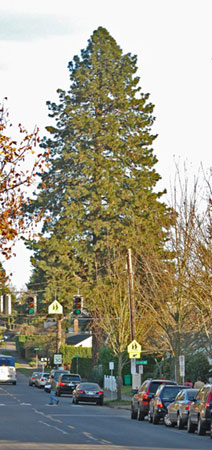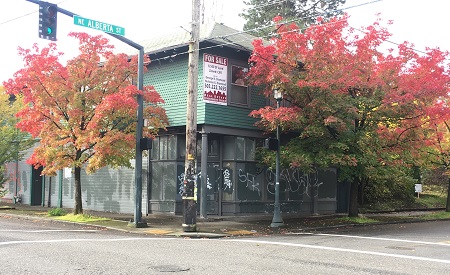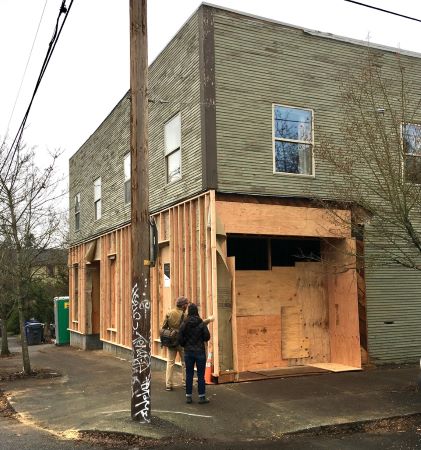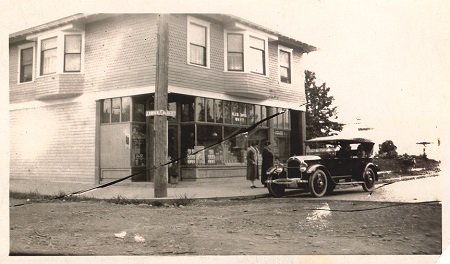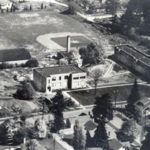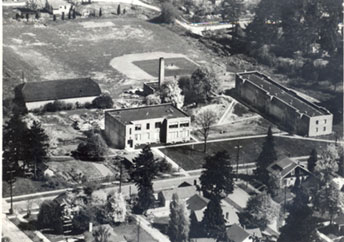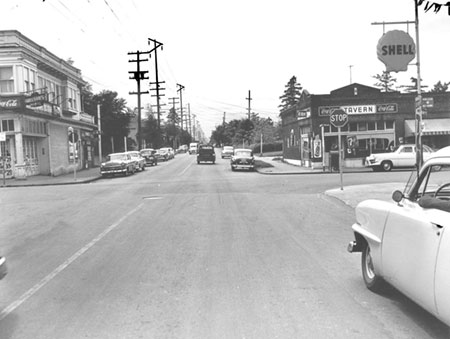By Leo Newman | Contributing Writer
Just Bob, the eclectic unicorn laden cafe is the latest business to operate out of the historic Alberta Pharmacy building on NE Alberta and 24th Ave, easily recognized by its seafoam exterior and iconic neon ‘Alberta Rexall Drugs’ sign. When Bob and Fayren Chang took over the cafe in 2014, they inherited a community of artists, performers and regulars with it.
A Convenient Doctor’s Office and Pharmacy
The Colonial Revival building was constructed at the eastern end of the Alberta Streetcar line in 1909. The first floor was designed for commercial use and the second story contained three apartments and some offices. Portland permit records show that E. R. Durst, one of the Alberta Pharmacy’s oldest traceable owners, began renovating the property in April, 1912. His wife led the Alberta Women’s Club, which met at 1030 East Twenty-Fourth Street North, now 4904 NE 24th Ave. In October, 1914, an elevator operator was found guilty of stealing the pharmacist’s bicycle and sentenced to “100 days on the rockpile.”
Just across Alberta was the office of Dr. Brown, who ran a family medical practice with a Dr. Chick. Though the doctor’s office would change hands a number of times, they maintained a close relationship with each other. For over half a century, getting your prescription filled was “as easy as crossing Alberta”, according to local residents. After the Second World War, Dr. Duncan Dickenson took over for the retiring Dr. Brown.
Paul Schimpf, 89, has lived across the street since the late thirties and has regularly eaten breakfast at the cafe with his friend Peter for nearly two decades. Schimpf remembers Chris Sorenson, the pharmacist that served Alberta from 1940 until his retirement in 1969. A Portland native, Sorenson was raised on NE Gantenbein Ave. and attended Jefferson High School and later the Oregon Agricultural College (now Oregon State University) in Corvallis.
Rexall Drugs, A Neighborhood Hangout
Shortly after purchasing the Alberta Pharmacy, Sorenson, along with thousands of independent pharmacists across the country, franchised the popular Rexall brand and installed the now iconic ‘Alberta Rexall Drugs’ sign off the second story. The Rexall Drug Company initially manufactured branded pharmaceutical goods for sale in retail stores. Rexall would contract with only one retailer in any given market. Its products could be found on the shelves of the Owl Drug Company in Downtown Portland, located across the street from its bitter rival, Meyer and Frank. By the late fifties, Rexall was the largest drugstore franchise in the U.S. with 11,158 stores, which is just shy of the number of McDonald’s in the country today.
“When I grew up, this is where you got your Rexall,” says Schimpf. “As you waited to get your prescription filled, you got a soda or a coffee at the bar.” The soda fountain bar ran down the right side of the store, as did the pharmacy counter. Along the right wall on the left were newspapers and magazines. Home goods, like diapers, could be found in the back of the store. Neighbors came to pay their bills, cash money orders and chat with friends around the soda fountain.
In the late 1970’s, the Rexall model of independent pharmacies began to lose out to larger competitors like Thrifty Drug and CVS Pharmacy. The workingclass neighborhood of Alberta also struggled to hold its own, accumulating boarded up buildings and enduring a record crime rate.
28 year-old Andy Kostechka, Alberta’s last pharmacist, threw in the towel in September 1981, one week after being held at gunpoint Alberta’s last pharmacist for the third time. An Oregonian article on the robbery described the pharmacy as “the last neighborhood gathering place that isn’t a tavern” and “a meeting place for adults at midday, and everybody’s kids after school.” At a final gathering in the pharmacy, neighbors shared Lorraine Schimpf’s carrot cake and drank coffee poured by Terry Olbekson, who tended the soda fountain for 21 years. When the store closed, many thought its defining neon sign would be shut off for good.
Bohemian Cafes with Creative Atmosphere
Still, the community continued to gather around its times-old meeting place. In 1993, Magnus Johannesson, a prominent figure in the Alberta Arts real estate scene, bought the property and rented the commercial space to a series of bohemian cafes; including The Rexall Rose and the Star E. Rose. Johannesson opened some of the upstairs lofts to veterans that had been on the streets since they had returned from Vietnam. The coffee houses hosted musicians and open mics and frequently advertised in alternative periodicals like Just Out. Johannesson maintained the property at a loss and when his bills went into default, the building changed hands.
By the time Bob and Fayren Chang arrived in 2014, the property was an Anna Bannanas cafe and its owners were looking to retire. The couple, fresh to Portland after running an English school in Taiwan, loved the building for its old bones, high ceiling and its creative atmosphere that most other coffee shops had lost.
Last December, Just Bob, along with building owner Eric Payne led the charge to relight the Rexall sign. Funded by a grant from the now defunct Alberta Main Street Association, the community gathered on New Year’s Eve 2025 to cheer the light being relit for the first time in over 30 years. Now the Changs keep the sign lit 24/7. “It’s a beacon of hope and optimism,” Fayren says, “especially on a dark foggy morning, casting its red glow down Alberta Street.”
Just Bob continues to host local artists and host various musicians and performers. Mary Rose and her string band have batted out folk standards and protest songs every Sunday for the last 30 odd years. Newcomers have also arrived to the scene, such as the cafe’s very own Gabe Holmes, who hosts a comedy open mic the last two Saturdays of each month. You can still find Paul Schimpf eating breakfast by the window. If you do, say hello.
Leo Newman is a paralegal and aspiring writer based in NE Portland. Trained as a historian, he enjoys exploring the history of Portland and the Pacific Northwest.


